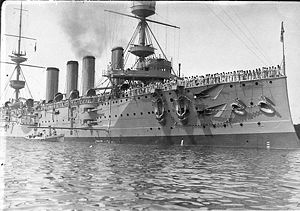Powerful-class cruiser

HMS Powerful in Sydney harbour.
|
|
| Class overview | |
|---|---|
| Name: | Powerful class |
| Operators: |
|
| Preceded by: | Edgar class |
| Succeeded by: | Diadem class |
| Built: | 1894–98 |
| In service: | 1897–1932 |
| Completed: | 2 |
| Scrapped: | 2 |
| General characteristics | |
| Type: | Protected cruiser |
| Displacement: | 14,200 long tons (14,400 t) (deep load) |
| Length: | |
| Beam: | 71 ft (21.6 m) |
| Draught: | 27 ft (8.2 m) |
| Installed power: | 25,000 shp (18,600 kW) |
| Propulsion: |
|
| Speed: | 22 knots (40.7 km/h; 25.3 mph) |
| Range: | 7,000 nmi (12,960 km; 8,060 mi) at 14 knots (25.9 km/h; 16.1 mph) |
| Complement: | 894 |
| Armament: |
|
| Armour: | |
The Powerful class were first-class protected cruisers built for the Royal Navy in the 1890s. There were two ships in the Powerful class, the lead ship, Powerful, and Terrible.
They were designed for hunting down commerce raiders such as the Russian armoured cruiser Rurik and numerous French armoured cruisers of the era. As a result, these were very large cruisers intended to be able to dominate other cruisers in a one-on-one battle. A secondary function was to act as a high speed, long range transport (which in fact was their only actual use during war).
The original armament was to be a uniform battery of twenty 6-inch guns. However, the Director of Naval Ordnance strongly believed that fewer larger (8-inch) guns would produce a better ship. The Office of Naval Construction countered that a 6-inch gun was suitable for fighting other cruisers, and that the 8-inch gun was too slow-firing to fight cruisers yet too small to fight battleships. He asked for at least a few guns of at least 9.2 inches as the smallest capable of damaging a contemporary battleship. This argument won, and the armament as constructed became two 9.2-inch guns and twelve 6-inch guns. Observers criticized these ships for their apparently light armament given their size. However, they had excellent sea keeping, high speed, and long range, all of which required space and tonnage.
These were the first cruisers in the Royal Navy with four funnels.
These ships had an armoured deck to stop plunging shells. This deck curved, with its crown in the middle of the ship 3 feet 6 inches (1.07 m) above the waterline, and the edges were 6 feet 6 inches (1.98 m) below the waterline. The deck was 6 inches (150 mm) thick over the machinery, 4 inches (100 mm) thick over the magazines, and 2.5 inches (64 mm) thick in the middle of the ship.
The dimensions of this class were limited by the then available dockyards available to build and maintain them.
In comparison to the Edgar class, these ships had a crew 64% larger, cost 61% more to build, had more than twice the horsepower, had 660 tons of armour versus 340 tons, were two knots faster, but had very nearly the same armament. The Edgar class remained to fight during the First World War, but the Powerful class had left the active fleet by then.
...
Wikipedia
